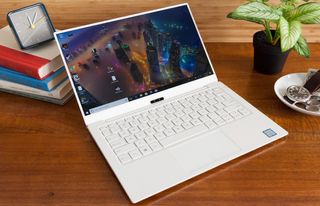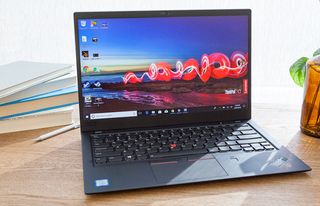The Best Laptops for Programming 2018
Programming requires a very particular breed of laptop — the kind that's equipped with processing power and hardware that might not be seen in everyday, average work machines. A smart set of baseline requirements for anyone shopping for a programming laptop include (at least) a Core i5 CPU, 8GB of RAM, a decent integrated graphics card and an SSD.

These specs are a good set of buying guidelines, but they don't narrow down the laptop selection pool nearly enough. To help you parse through the crowded marketplace, we compiled our top choices for programmers.

Asus ZenBook 13 UX331UN
Packing 8GB of RAM, a Core i5-8250U CPU and a GeForce MX150, the Asus ZenBook 13 UX331UN is a good lower-midtier option for coders looking to dig into computationally intensive programs. As proof of its graphics mettle, consider that this laptop ran Dirt 3 at 114 frames per second. As a bonus, the laptop sports a solid battery-life average of 9 hours and 11 minutes, meaning if you ever get really into a task without having a charger handy, you'll have a good window of time to wrap things up. Also worth mentioning is that the ZenBook 13 sports a lot of useful ports, including two USB 3.0 ports, a microSD card reader and an HDMI port for connecting to an external monitor.Keyspecs: CPU:1.6-GHz Intel Core i5-8250U | RAM: 8GB | Storage: 256GB | GPU: Nvidia GeForce MX150, Intel UHD Graphics 620 | Display:13.3 inches (1920 x 1080) | Weight: 2.7 pounds Asus ZenBook 13 UX331UN Review

Apple MacBook Pro 15-inch
For programmers with an affinity for AMD GPUs, this is a noteworthy entry on the list. The 15-inch Apple MacBook Pro sports a Radeon Pro 560, a 2.9-GHz Intel Core i7 processor and 16GB of RAM, meaning it's equipped to be a programming workhorse. That 16GB of RAM is especially useful for juggling multiple intensive programs at once without hitting any lag or freezing. Plus, the 15-inch MacBook Pro sports impressive speakers. This MacBook Pro also rocks an 11 hour battery life. Worth noting, however, is that areas like the keyboard can run a little hot on the hands if you push this machine to its limits for a extended period. Keyspecs: CPU: 2.9-GHz quad-core Intel Core i7 | RAM: 16GB | Storage: 512GB | GPU: AMD Radeon Pro 560 | Display:15.4 inches (2800 x 1800) | Weight: 4 pounds Apple MacBook Pro 15-inch Review

Dell XPS 13
Any programmer who needs a crisp, vibrant and (virtually) bezel-less screen for coding projects should take a good look at Dell's XPS 13, which sports a notably attractive display. This machine is one of the slimmest on the entire list, making it great for working on the go, especially when you factor in its strong battery life. When you add in the machine's 8GB of RAM and Core i7 CPU, it's clear the XPS 13 isn't just a looker; it packs a respectable hardware punch as well. However, it has zero USB Type-A ports, so be mindful of that.KeySpecs: CPU: 1.8-GHz Intel Core i7-8550U | RAM: 8GB | Storage: 256GB | GPU: Intel UHD Graphics 620 | Display:13.3 inches (1920 x 1080) | Weight: 2.7 pounds Dell XPS 13 Review

HP EliteBook 840 G5
The HP EliteBook 840 G5 is a solid all-rounder, sporting a respectable 8-and-a-half-hour battery life, a Core i7 CPU, 16GB of RAM, 512GB of storage, quality audio and a well-designed keyboard. As with other laptops on the list, the 16GB of RAM is an especially valuable trait, as it enables the EliteBook to juggle a lot of heavy-hitting processes at once without crippling performance in the process. And, as icing on the cake, the machine also has an HDMI port, in addition to all the usual ones (a USB Type-C port, 3.0 port, headphone/mic jack, etc.).Keyspecs: CPU: 1.9-GHz Intel Core i7-8650U | RAM: 16GB | Storage: 512GB SSD | GPU: Intel UHD Graphics 620 | Display:14 inches (1920x1080) | Weight: 3.4 pounds HP EliteBook 840 G5 Review

Lenovo ThinkPad X1 Carbon
Of all the laptops to make it onto this list, few are as capable as the Lenovo ThinkPad X1 Carbon. As our review states, this laptop has just about everything: a stunning HDR display, 11 hours of battery life, a best-in-class keyboard, and a lightweight, stylish design. Not to mention, the Carbon also packs 16GB of RAM and 512GB of storage. For those who want to look good while they work hard, this is the portable, powerful, premium programming laptop to get. Do note, though, that the sound from its speakers are rather tinny — so if you like what you see with the Carbon, you might want to grab a set of headphones in advance. Keyspecs: CPU: 1.6-GHz Intel Core i5-8250U | RAM: 16GB | Storage: 512GB SSD | GPU: Intel UHD Graphics 620 | Display:14 inches (1920 x 1080) | Weight: 2.5 pounds Lenovo ThinkPad X1 Carbon Review

MSI GS65 Stealth Thin
This laptop is designed exclusively for the coders who believe that one man (or woman) should have all that power. If you plan on running the most graphically intensive programming software there is, you're going to want the MSI GS65 Stealth Thin. It packs a beefy Nvidia GeForce GTX 1070 Max-Q GPU (which can run any game you throw at it), an intense 3.9-GHz Intel Core i7-8750H processor and 16GB of RAM. No matter what you need to run, or what you want to do, with this laptop, its specs mean it'll (likely) be more than up to the task. Equipped with killer speakers, a 144-Hz display and a ton of ports (including HDMI), the GS65 Stealth Thin is a beast. Note, though, that all this performance comes at a cost, both financially and in terms of the heat this laptop produces. Keyspecs: CPU:3.9-GHz Intel Core i7-8750H | RAM: 16GB | Storage: 512GB SSD | GPU: Nvidia GeForce GTX 1070 Max-Q | Display:15.6 inches (1920 x 1080) | Weight: 4.1 pounds MSI GS65 Stealth Thin Review

Microsoft Surface Pro
For programmers in need of a touch-screen-equipped laptop with requisite coding horsepower, Microsoft's Surface Pro answers the call. Rocking a Core i7 CPU, 16GB of RAM and a hefty 1TB of storage, this laptop is great for programmers who like to stockpile tons of files. And it weighs only 1.7 pounds, meaning it's perfect for travel. The Surface Pro's only real drawback is its somewhat underwhelming 7-and-half-hour battery life. Keyspecs: CPU: 2.5-GHz Intel Core i7-7660U | RAM: 16GB | Storage: 1TB SSD | GPU: Intel Iris Plus Graphics 640 | Display:12.3 inches (2736 x 1824) | Weight: 1.7 pounds Microsoft Surface Pro Review

Razer Blade
Similar to the MSI GS65 Stealth Thin, the Razer Blade is a graphical powerhouse that packs a lot of impressive hardware into a petite, portable frame. If it can run Rise of the Tomb Raider at very high settings at 1080p averaging 77 fps, it's more than equipped to tackle any graphically intensive task. Plus, it has a battery life of almost 6 hours, which is quite the rarity when dealing with laptops of this power tier. And it has an ever-useful HDMI port. Frankly, the Razer Blade's only major programming-specific drawback would be its uncomfortable keyboard, which might hamper coders with killer word-per-minute rates.Keyspecs: CPU: 2.2-GHz Intel Core i7-8750H | RAM: 16GB | Storage: 512GB SSD | GPU: Nvidia GeForce GTX 1070 Max-Q | Display:15.6 inches (1920 x 1080) | Weight: 4.6 pounds Razer Blade Review

Samsung Notebook 9 Pro
For programmers who prefer touch screens and AMD GPUs, this is the niche-specific laptop to get. Though it includes only 256GB of storage, it packs 16GB of RAM, a Core i7 CPU and a good assortment of ports, making it versatile enough for most programming situations. Its only major drawbacks are the loads of bloatware it comes with and its measly 7 hours of battery life. Keyspecs: CPU:2.7-GHz Intel Core i7-7500U | RAM: 16GB | Storage: 256GB SSD | GPU: AMD Radeon 540 Graphics with 2GB of VRAM / Intel HD Graphics 620 | Display:15 inches (1920 x 1080) | Weight: 3.8 pounds Samsung Notebook 9 Pro Review
Credit: Laptop Mag
Stay in the know with Laptop Mag
Get our in-depth reviews, helpful tips, great deals, and the biggest news stories delivered to your inbox.
